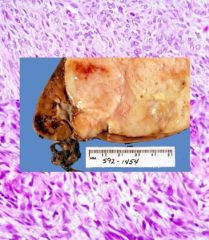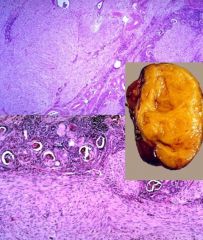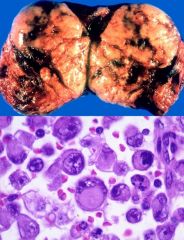![]()
![]()
![]()
Use LEFT and RIGHT arrow keys to navigate between flashcards;
Use UP and DOWN arrow keys to flip the card;
H to show hint;
A reads text to speech;
3 Cards in this Set
- Front
- Back

|
Clear Cell Sarcoma
1. Age: 1-3 years 2. Associations: none. 3. This tumor is at least 10 times as likely to metastasize to bone as any other pediatric renal tumor, so it is sometimes referred to as the “bone metastasizing tumor of childhood” 4. Clinical features: 66% of patients are male 5. Gross: variable: may be homogeneous gray and lobular, or may be firm and light pink with whorled areas; usually well-circumscribed; bilaterality has not been reported 6. Histology: • cells have lightly-staining cytoplasm (not optically clear as in renal cell carcinoma) • cells are arranged in cords or packets separated by fibrovascular septa with “chicken-wire” appearance • typically has infiltrative borders 7. Prognosis: death rate = 30-40% with chemotherapy; late recurrences do occur. |
|

|
Mesoblastic Nephroma: Classical form
1. Age: <3 months; uncommon after 6 months 2. Associations: polyhydramnios and prematurity 3. Gross: relatively large tumor with a firm white whorled cut surface; unencapsulated 4. Histology: • moderately cellular spindle-cell neoplasm with elongated nuclei • margins are infiltrative, with cells extending into the adjacent renal and perirenal tissues • although cellular, this neoplasm typically has very few mitotic figures (0-1 per 10 high-power fields) 5. Clinical behavior: surgical resection is invariable curative. 6. Adverse prognostic indicators: age > 3 months; incomplete resection; ? cellular histologic pattern |
|

|
Rhabdoid Tumor
1. Age: generally < 1 yr; rarely over 3 years. 2. Associations: embryonal tumors of CNS and paraneoplastic hypercalcemia 3. Gross: yellow-gray or light tan friable tumor with infiltrative borders; more often located in the renal medulla; 4. Histology: • large polygonal cells with abundant eosinophilic cytoplasm • round nuclei with prominent membranes and large nucleoli • cytoplasm typically contains large round eosinophilic inclusions that push the nucleus to the side of the cell • appearance simulates primitive skeletal muscle (hence the name "rhabdoid") -- however stains for skeletal muscle differentiation (such as desmin, muscle specific actin, etc.) should be negative. If there is any positivity by these stains, the tumor is more appropriately classified as a rhabdomyosarcoma than as a rhabdoid tumor. 5. Clinical behavior: extremely aggressive, malignant tumor: death from metastatic disease occurs within 12 months in 75% of patients. |

